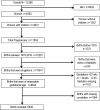Racial/Ethnic Disparities in Inadequate Gestational Weight Gain Differ by Pre-pregnancy Weight
- PMID: 25652057
- PMCID: PMC4503500
- DOI: 10.1007/s10995-015-1682-5
Racial/Ethnic Disparities in Inadequate Gestational Weight Gain Differ by Pre-pregnancy Weight
Abstract
Pre-pregnancy body mass index (BMI) varies by race/ethnicity and modifies the association between gestational weight gain (GWG) and adverse pregnancy outcomes, which disproportionately affect racial/ethnic minorities. Yet studies investigating whether racial/ethnic disparities in GWG vary by pre-pregnancy BMI are inconsistent, and none studied nationally representative populations. Using categorical measures of GWG adequacy based on Institute of Medicine recommendations, we investigated whether associations between race/ethnicity and GWG adequacy were modified by pre-pregnancy BMI [underweight (<18.5 kg/m(2)), normal weight (18.5-24.9 kg/m(2)), overweight (25.0-29.9 kg/m(2)), or obese (≥30.0 kg/m(2))] among all births to Black, Hispanic, and White mothers in the 1979 USA National Longitudinal Survey of Youth cohort (n = 6,849 pregnancies; range 1-10). We used generalized estimating equations, adjusted for marital status, parity, smoking during pregnancy, gestational age, and multiple measures of socioeconomic position. Effect measure modification between race/ethnicity and pre-pregnancy BMI was significant for inadequate GWG (Wald test p value = 0.08). Normal weight Black [risk ratio (RR) 1.34, 95 % confidence interval (CI) 1.18, 1.52] and Hispanic women (RR 1.33, 95 % CI 1.15, 1.54) and underweight Black women (RR 1.38, 95 % CI 1.07, 1.79) experienced an increased risk of inadequate GWG compared to Whites. Differences in risk of inadequate GWG between minority women, compared to White women, were not significant among overweight and obese women. Effect measure modification between race/ethnicity and pre-pregnancy BMI was not significant for excessive GWG. The magnitude of racial/ethnic disparities in inadequate GWG appears to vary by pre-pregnancy weight class, which should be considered when designing interventions to close racial/ethnic gaps in healthy GWG.
Figures



Similar articles
-
Racial differences in gestational weight gain and pregnancy-related hypertension.Ann Epidemiol. 2014 Jun;24(6):441-7. doi: 10.1016/j.annepidem.2014.02.009. Epub 2014 Mar 3. Ann Epidemiol. 2014. PMID: 24685832 Free PMC article.
-
Racial/ethnic variations in gestational weight gain: a population-based study in Ontario.Can J Public Health. 2019 Oct;110(5):657-667. doi: 10.17269/s41997-019-00250-z. Epub 2019 Aug 26. Can J Public Health. 2019. PMID: 31452112 Free PMC article.
-
Maternal pre-pregnancy weight and gestational weight gain and their association with birthweight with a focus on racial differences.Matern Child Health J. 2013 Jan;17(1):85-94. doi: 10.1007/s10995-012-0950-x. Matern Child Health J. 2013. PMID: 22322428 Free PMC article.
-
Racial-ethnic differences in pregnancy-related weight.Adv Nutr. 2012 Jan;3(1):83-94. doi: 10.3945/an.111.000984. Epub 2012 Jan 5. Adv Nutr. 2012. PMID: 22332106 Free PMC article. Review.
-
Racial discrimination and the black-white gap in adverse birth outcomes: a review.J Midwifery Womens Health. 2011 Jul-Aug;56(4):362-370. doi: 10.1111/j.1542-2011.2011.00034.x. J Midwifery Womens Health. 2011. PMID: 21733107 Free PMC article. Review.
Cited by
-
Pregnancy-Related Weight and Postpartum Depressive Symptoms: Do the Relationships Differ by Race/Ethnicity?J Womens Health (Larchmt). 2021 Jun;30(6):816-828. doi: 10.1089/jwh.2019.8175. Epub 2020 Oct 20. J Womens Health (Larchmt). 2021. PMID: 33085545 Free PMC article.
-
Pregnancy Outcomes and Documentation Status Among Latina Women: A Systematic Review.Health Equity. 2020 May 11;4(1):158-182. doi: 10.1089/heq.2019.0126. eCollection 2020. Health Equity. 2020. PMID: 32440614 Free PMC article. Review.
-
Weight gain during twin pregnancy with favorable pregnancy outcomes in Japan: A retrospective investigation for new criteria based on perinatal registry data.PLoS One. 2021 Jul 2;16(7):e0253596. doi: 10.1371/journal.pone.0253596. eCollection 2021. PLoS One. 2021. PMID: 34214100 Free PMC article.
-
Comparison of Self-reported and Measured Pre-pregnancy Weight: Implications for Gestational Weight Gain Counseling.Matern Child Health J. 2017 Jul;21(7):1469-1478. doi: 10.1007/s10995-017-2266-3. Matern Child Health J. 2017. PMID: 28155023
-
The effects of culture on guideline discordant gestational weight gain: a systematic review protocol.Syst Rev. 2015 Nov 3;4:145. doi: 10.1186/s13643-015-0132-1. Syst Rev. 2015. PMID: 26527534 Free PMC article.
References
-
- Braveman P. Black–White disparities in birth outcomes: Is racism-related stress a missing piece of the puzzle? In: Lemelle AJ, Reed W, Taylor S, editors. Handbook of African American Health: Social and Behavioral Interventions. New York, NY: Springer New York; 2011. pp. 155–163.
-
- Dixon B, Rifas-Shiman SL, James-Todd T, et al. Maternal experiences of racial discrimination and child weight status in the first 3 years of life. J Devel Orig Health Dis. 2012;3(06):433–441. - PubMed
-
- Rasmussen KM, Yaktine AL, editors. Weight gain during pregnancy. Washington, DC: National Academies Press (US); 2009. - PubMed
-
- National Center for Chronic Disease Prevention and Health Promotion, Activity D.O.N.A.P., editor. Pediatric and Pregnancy Nutrition Surveillance System. 2013. Nation: Summary of Trends in Maternal Health Indicators by Race/Ethnicity. Table 20D.
Publication types
MeSH terms
Grants and funding
LinkOut - more resources
Full Text Sources
Other Literature Sources
Medical

